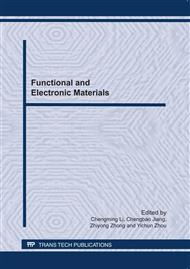p.411
p.416
p.422
p.427
p.433
p.439
p.447
p.450
p.457
The Microstructure and Dielectric Properties of SrTiO3 Modified 0.9Pb(Mg1/3Nb2/3)O3-0.1PbTiO3 Ceramics
Abstract:
The microstructure and dielectric properties of ferroelectric solutions which is formulated with (1-x)[0.9Pb(Mg1/3Nb2/3)O3-0.1PbTiO3]-x mol% SrTiO3 (x=0, 1, 3 and 5) have been investigated. The ceramics was fabricated by a modified columbite route sintered at 1200 °C. The effects of dopants on microstructure, maximum dielectric constant (εm) and diffuseness of the phase transition, etc. have been studied. It is found that the maximum permittivity (εm) increases to 24968 for the ST-doped (1 mol %) sample, subsequently decreases with ST addition and its corresponding phase-transition-temperature (Tm) shifts to the lower temperature. The variation of εm is caused by the decrease of polar nano-region size, increase of the fluctuation of the component and the increase of the effective spontaneous polarization. The enhancement of relaxor behavior in the PMN-PT sample is explained by the decrease of FE/AFE coupling.
Info:
Periodical:
Pages:
433-438
Citation:
Online since:
June 2011
Authors:
Price:
Сopyright:
© 2011 Trans Tech Publications Ltd. All Rights Reserved
Share:
Citation:


